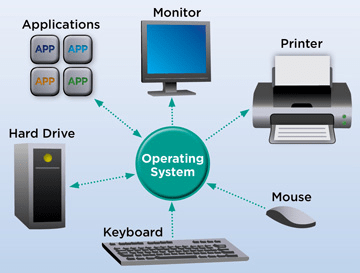When developing leaders, I think it is helpful to make a comparison between leaders and computers.
If I want to upgrade a computer, I have two primary options:
- I can add on new programs to broaden its functionality
- I can upgrade its operating system
Out of these two options, I think that most leadership development efforts focus on the first option, adding on new programs. While such development surely has its place, I believe the priority should be on upgrading leaders’ operating systems.
Leaders’ Internal Operating System
An operating system is the most important aspect of a computer. It runs the show. Its primary job is to coordinate the programs operating on the computer, making sure each gets what it needs such that the user is able to do what he or she needs to do efficiently and effectively. It is difficult to appreciate the computer’s operating system because you can’t see it, you can only observe its effectiveness by how the programs function.

Leaders have a complex system of mindsets, self-regulatory strategies, values, beliefs, assumptions, fears, self-awareness, emotional intelligence, and identities that serve as their internal operating system that:
- Focus their attention
- Influence their choices
- Drives their behavior
- Determines the effectiveness of their actions
Just like in a computer, leaders’ internal operating systems manage the programs (knowledge, skills, and capabilities) that the leader possesses. And, it is difficult to appreciate because it is difficult to observe directly. You can only observe its effectiveness by how its programs function.
I think this is the reason why most leadership development focuses on the programs. If a certain program isn’t working effectively, like inclusiveness, we send them to an inclusiveness training thinking that will solve the problem.
Case Study: Ballmer vs. Nadella
To help these ideas come to life, let’s compare and contrast the last two CEOs of Microsoft: Steve Ballmer (2000-2014) and Satya Nadella (2014-current).

My belief is that both of these men have roughly the same base programs to effectively lead a large organization. But, I do think they have very different internal operating systems. Here is a summary of some of their differences:
|
Steve Ballmer |
Satya Nadella |
|
| Taking the Stage | Like a rock show: loud music; dancing around; yelling; focused on hyping up the crowd | Deliberate: Focused on elevating the audience, often through clarity of purpose, mission, or direction |
| Mission Statement | Microsoft didn’t have a strong or unique mission statement during his tenure | One of the first things Nadella focused on when he became CEO was developing a clear mission statement: “To empower every person and every organization on the planet to achieve more.” A guiding force today. |
| Approach Toward Competitors | Compete. He wouldn’t let his kids use Google or Apple services or products. | Collaborate. He wants to make sure their billion customers have access to Microsoft services regardless of the phone or platform they choose to use. |
| Culture | Ballmer established a stacked-ranked performance evaluation system that killed Microsoft’s culture. | Nadella says that the “C” in CEO stands for “Curator of Culture.” Nadella has dramatically improved Microsoft’s culture. |
Ballmer’s internal operating system seems focused on standing out. Nadella’s internal operating system seems focused on contribution and moving forward.
The difference in effectiveness is dramatic. During Ballmer’s tenure, Microsoft’s market share and stock price stayed the same. And, his Glassdoor approval rating was 40%, the lowest of large tech CEOs. Since Nadella has taken over, Microsoft’s market share and stock price are up almost six-fold. And, his Glassdoor approval rating was 97%, among the highest of all CEOs of large organizations.
Good News
The key to a leader’s effectiveness is their underlying internal operating system.
The good news about this is that we can upgrade leaders’ internal operating systems. It is possible for someone like Steve Ballmer to upgrade their operating system to operate more like Satya Nadella’s.
Recognizing this, the primary focus of leadership development should be focused on the leaders’ internal operating systems. Unfortunately, that is rarely the case.
In the next five articles, I will be focusing on the different internal operating systems that leaders use (Mind 1.0, Mind 2.0, and Mind 3.0), and how we can help leaders upgrade from either Mind 1.0 or Mind 2.0 to Mind 3.0.
In the meantime, if you would like more content on this topic, check out:










